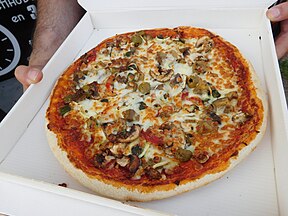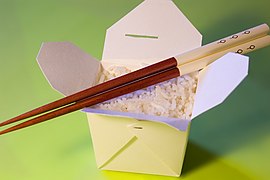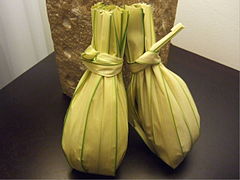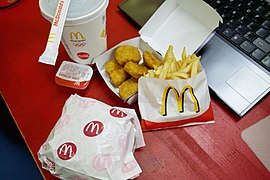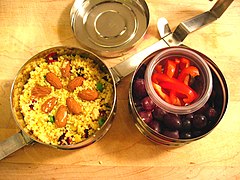Take-out
Take-outortakeoutis a prepared meal or other food items, purchased at a restaurant orfast foodoutlet with the intent to eat elsewhere. A concept found in many ancient cultures, take-out food is common worldwide, with a number of different cuisines and dishes on offer.
Other names
[edit]Such a meal may also be called acarry-out(U.S., Canada and the Philippines); ato-go(Scotland and some dialects in the U.S. and Canada);[1]atakeaway(England, Wales, Australia, Lebanon, South Africa, Northern Ireland and Republic of Ireland, and occasionally in North America);[1]takeaways(India,New Zealand);grab 'n go(Canada); apack(Nepal); aparcel(Bangladesh,Pakistan);[2]ordabao(Singapore).
History
[edit]
The concept of prepared meals to be eaten elsewhere dates back to antiquity. Market and roadside stalls selling food were common inAncient GreeceandRome.[3]InPompeii,archaeologists have found a number ofthermopolia,service counters opening onto the street which provided food to be taken away. There is a distinct lack of formal dining and kitchen area in Pompeian homes, which may suggest that eating, or at least cooking, at home was unusual. Over 200thermopoliahave been found in the ruins of Pompeii.[4]
In the cities of medieval Europe a number of street vendors sold take-out food. In medieval London, street vendors sold hot meatpies,geese,sheep's feetand Frenchwine,while in Paris roastedmeats,squab,tartsandflans,cheesesand eggs were available. A large strata of society would have purchased food from these vendors, but they were especially popular amongst the urban poor, who would have lacked kitchen facilities in which to prepare their own food.[5]However, these vendors often had a bad reputation, often being in trouble withcityauthorities reprimanding them for selling infected meat or reheated food. The cooks ofNorwichoften defended themselves in court against selling such things as "pokkypies "and" stynkyng mackerelles ".[6]In 10th and 11th centuryChina,citizens of cities such asKaifengandHangzhouwere able to buy pastries such asyuebingandcongyoubingto take away. By the early 13th century, the two most successful such shops in Kaifeng had "upwards of fifty ovens".[7]A traveling Florentine reported in the late 14th century that inCairo,people carried picnic cloths made ofrawhideto spread on the streets and eat their meals oflambkebabs,riceandfrittersthat they had purchased from street vendors.[8]In RenaissanceTurkey,many crossroads saw vendors selling "fragrant bites of hot meat", including chicken and lamb that had beenspit roasted.[9]
Aztecmarketplaces had vendors that sold beverages such asatole( "agruelmade frommaizedough "), almost 50 types oftamales(with ingredients that ranged from the meat ofturkey,rabbit,gopher,frog,and fish, fruit, eggs, and maize flowers),[10]as well as insects and stews.[11]After Spanish colonization of Peru and importation of European food stocks includingwheat,sugarcaneand livestock, most commoners continued primarily to eat their traditional diets, but did add grilled beef hearts sold by street vendors.[12]Some of Lima's 19th century street vendors such as "Erasmo, the 'negro' sango vendor" and Na Aguedita are still remembered today.[13]

During theAmerican colonial period,street vendors sold "pepper pot soup" (tripe) "oysters, roasted corn ears, fruit and sweets," with oysters being a low-priced commodity until the 1910s whenoverfishingcaused prices to rise.[14]In 1707, after previous restrictions that had limited their operating hours,street food vendorshad been banned in New York City.[15]Many women of African descent made their living selling street foods in America in the 18th and 19th centuries; with products ranging from fruit, cakes and nuts inSavannah, Georgia,to coffee, biscuits, pralines and other sweets inNew Orleans.[16]In the 19th century, street food vendors inTransylvaniasold gingerbread-nuts, cream mixed with corn, and bacon and other meat fried on tops of ceramic vessels with hot coals inside.[17]
TheIndustrial Revolutionsaw an increase in the availability of take-out food. By the early 20th Century,fish and chipswas considered an "established institution" in Britain. Thehamburgerwas introduced to America around this time. The diets of industrial workers were often poor, and these meals provided an "important component" to their nutrition.[18]In India, local businesses and cooperatives, had begun to supply workers in the city ofBombay(now Mumbai) withtiffinboxes by the end of the 19th century.[19]
TheCOVID-19 pandemicled to many restaurants closing their indoor dining spaces and only offering take-out.[20][21]
Business operation
[edit]
Take-out food can be purchased from restaurants that also provide sit-downtable serviceor from establishments specialising in food to be taken away.[22]Providing a take-out service saves operators the cost of cutlery, crockery and pay for servers and hosts; it also allows many customers to be served quickly, without restricting sales by remaining to eat their food.[23]
Street food
[edit]
Although once popular in Europe and America,[5]street fooddeclined in popularity in the 20th century. In part, this can be attributed to a combination of the proliferation of specialized takeaway restaurants and legislation relating to health and safety.[5]Vendors selling street food are still common in parts of Asia, Africa and the Middle East,[24]with the annual turnover of street food vendors in Bangladesh and Thailand being described as particularly important to the local economy.[25]
Drive-through
[edit]In the United States, many restaurants and take-out establishments offerdrive-throughordrive-thru[26]outlets that allow customers to order, pay for, and receive food without leaving their cars. The idea was pioneered in 1931 in a Californiafast foodrestaurant,Pig Stand Number 21.By 1988, 51% ofMcDonald'sturnover was being generated bydrive-throughs,with 31% of all US take-out turnover being generated by them by 1990.[27]
Food delivery
[edit]
Some take-out businesses offer prepared food for delivery, which usually involves contacting a local restaurant by telephone or online. In countries including Australia, Canada, India, Brazil, Japan, much of the European Union and the United States, food can be ordered online from a menu, then picked up by the customer or delivered by the restaurant or a third party delivery service.[28]The industry has kept pace with technological developments since the 1980s, beginning with the rise of the personal computer and continuing with the rise of mobile devices andonline delivery applications.Specialized computer software for food delivery helps determine the most efficient routes for carriers, track order and delivery times, manage calls and orders withPoSsoftware, and other functions. Since 2008satellite navigationtracking technology has been used for real-time monitoring of delivery vehicles by customers over the Internet.[29]

A restaurant can either maintain its own delivery personnel or use third parties who contract with restaurants to not only deliver food orders but also assist in marketing and providing order-taking technology. The field has seen rapid growth since the late 2000s with the spread of the smart phones and apps enabling customers to order from their mobile devices.[30]In 2024 it was reported, that food delivery companies in the Unite States and Europe had amassed more than $20bn in combined operating losses. ThesharesofDeliveroo,Just Eat Takeaway,Delivery Hero,andDoorDashwere therefore trading below the value that was delivered during theCOVID-19 pandemic.[31]
Some businesses offer a guarantee to deliver within a predetermined period of time, with late deliveries not charged for.[32]For example,Domino's Pizzahad a commercial campaign in the 1980s and early 1990s for itspizza deliveryservice which promised "30 minutes or it's free". This was discontinued in the United States in 1993 due to the number of lawsuits arising from accidents caused by hurried delivery drivers.[33]
Packaging
[edit]Take-out food is packaged in paper,paperboard,corrugated fiberboard,plastic, orfoam food containers.One common container is theoyster pail,a folded, waxed or plastic coated, paperboard container. The oyster pail was quickly adopted, especially inthe West,for "Chinese takeout".[34]
In Britain old newspapers were traditionally used for wrapping fish and chips until this was banned for health reasons in the 1980s.[35]Many people are nostalgic for this traditional wrapping; some modern fish and chip shops wrap their food in faux-newspaper, food-safe paper printed to look like a newspaper.[36]
Corrugated fiberboard and foam containers are to some extent self-insulating,and can be used for other foods.Thermal bagsand otherinsulated shipping containerskeep food hot (or cold) more effectively for longer.
Aluminiumcontainers are also popular for take-out packaging due to their low cost.Expanded polystyreneis often used for hot drinks containers and food trays because it is lightweight and heat-insulating.[37]
All types of container can be produced with supplier information and design to create abrand identity.[38]
-
Pizza served in a cardboard box.
-
Boiled rice served in anoyster pail.
-
Leaf-wrapped rice dish (nasi kuning)
-
Paper-wrapped food carryingMcDonald'sfood; includingChicken McNuggets,fries, burger, and drink
-
Take-out food in Thailand is often packaged in plastic bags
-
Orizumebento
-
Tiffin carrieror dabba
-
Chinese restaurant counter in a Northside Chicago neighborhood
Disposable serviceware waste
[edit]
Packagingof fast food and take-out food is necessary for the customer but involves a significant amount of material that ends up in landfills, recycling, composting, or litter.[39]Foam containers for fast-food were the target of environmentalists in the U.S. and were largely replaced with paper wrappers among large restaurant chains.[40]
In 2002,Taiwanbegan taking action to reduce the use ofdisposable tablewareat institutions and businesses, and to reduce the use of plastic bags. Yearly, the nation of 17.7 million people was producing 59,000 tons of disposable tableware waste and 105,000 tons of waste plastic bags, and increasing measures have been taken in the years since then to reduce the amount of waste.[41]In 2013, Taiwan's Environmental Protection Administration (EPA) banned outright the use of disposable tableware in the nation's 968 schools, government agencies, and hospitals. The ban was expected to eliminate 2,600 metric tons of waste yearly.[42]
InGermany,Austria,andSwitzerland,laws banning the use of disposable food and drink containers at large-scale events have been enacted. Such a ban has been in place inMunich, Germanysince 1991, applying to all city facilities and events. This includes events of all sizes, including very large ones (Christmas market, Auer-Dult Faire, Oktoberfest and Munich City Marathon). For small events of a few hundred people, the city has arranged for a corporation to offer rental of crockery and dishwasher equipment. In part through this regulation, Munich reduced the waste generated byOktoberfest,which attracts millions of people,[43]from 11,000 metric tons in 1990 to 550 tons in 1999.[44]
China, by virtue of the size of its population and the surging popularity of food delivery apps, such as Meituan and Ele.me, faces significant challenges disposing of or recycling takeout foodpackaging waste.[45]According to a 2018 study published inResources, Conservation and Recycling,for the first half of 2017, Chinese consumers ordered 4.6 billion takeout meals, generating "significant environmental concerns". The study's authors estimated that packaging waste from food delivery grew from 20,000 metric tons in 2015 to 1.5 million metric tons in 2017.[46]In 2018,Meituanreported making over 6.4 billion food deliveries, up from 4 billion a year earlier.[47]
Because takeout and delivery meals in China includesingle-usechopsticks, which are made from wood or bamboo, the growth in food delivery also has an impact on China's forests.[48]China produces about 80 billion pairs of single-usechopsticksyearly, the equivalent of 20 million 20-year-old trees.[49]About 45 percent are made from trees – mainly cottonwood, birch, and spruce, the remainder being made from bamboo.Japanuses about 24 billion pairs of these disposables per year, and globally about 80 billion pairs are thrown away by an estimated 1.4 billion people. In 2013 in Japan, one pair of disposable chopsticks cost US$0.02. One pair of reusable chopsticks cost $1.17, and each pair could be used 130 times. A cost of $1.17 per pair divided by 130 uses comes to $0.009 (0.9¢) per use, less than half the cost of disposable. Campaigns in several countries to reduce this waste are beginning to have some effect.[50][51][needs update]
See also
[edit]- Condiment sachet
- Leftovers
- Oyster pail,a type of paper container from America that later became used with Chinese American cuisine
- Pizza delivery
- Street food
References
[edit]- ^ab"takeaway noun - Definition, pictures, pronunciation and usage notes".Oxford Advanced Learner's Dictionary at OxfordLearnersDictionaries.com.RetrievedJune 18,2021.
- ^"Sunday Levity: Paradise Secured".The Acorn.RetrievedSeptember 1,2008.
But we're only here for a take-away (orparcel,in local parlance).
- ^Smith, Andrew F., ed. (2007).The Oxford Companion to American Food and Drink.Oxford, UK: Oxford University Press. pp.580.ISBN9780195307962.
- ^Weiss Adamson, Melitta; Segan, Francine, eds. (October 30, 2008).Entertaining from Ancient Rome to the Super Bowl: An Encyclopedia.CT, USA: Greenwood Press. pp. 252–253.ISBN9780313086892.
- ^abcHarris, Stephen; Grigsby, Bryon L., eds. (2007).Misconceptions about the Middle Ages.London, UK: Routledge. p. 166.ISBN9781135986674.
- ^Harper-Bill, Christopher, ed. (2005).Medieval East Anglia.Sussex, UK: The Boydell Press. p. 134.ISBN9781843831518.
- ^Fredman Cernea, Ruth, ed. (2005).The Great Latke-Hamantash Debate.London, UK: University of Chicago Press. pp.181.ISBN9780226100234.
- ^Mary Snodgrass - (September 27, 2004).Encyclopedia of Kitchen History.Taylor & Francis.ISBN9780203319178.RetrievedAugust 16,2012.
- ^Mary Snodgrass (September 27, 2004).Encyclopedia of Kitchen History.Taylor & Francis.ISBN9780203319178.RetrievedAugust 16,2012.
- ^Susan Evans (2001).Archaeology of Ancient Mexico and Central America: An Encyclopedia.Taylor & Francis.ISBN9780815308874.RetrievedAugust 17,2012.
- ^Long Towell Long, Luis Alberto Vargas (2005).Food Culture In Mexico.Bloomsbury Academic.ISBN9780313324314.RetrievedAugust 17,2012.
- ^J. Pilcher (December 20, 2005).Food In World History.ISBN9780203970058.RetrievedAugust 16,2012.
- ^Ken Albala (May 25, 2011).Food Cultures of the World Encyclopedia.Boo.ISBN9780313376269.RetrievedAugust 17,2012.
- ^Katherine Leonard Turner (2008).Good Food for Little Money: Food and Cooking Among Urban Working-class...ISBN9780549754237.RetrievedAugust 17,2012.
- ^Artemis P. Simopoulos(2000).Street Foods.ISBN9783805569279.RetrievedAugust 16,2012.
- ^Bower, Anne L. (December 2008).African American Foodways: Explorations of History and Culture -.ISBN9780252076305.RetrievedAugust 17,2012.
- ^Walker, Harlan (1992).Oxford Symposium on Food and Cookery 1991: Public Eating: Proceedings.ISBN9780907325475.RetrievedAugust 17,2012.
- ^Harbottle, Lynn (2004).Food for Health, Food for Wealth: Ethnic and Gender Identities in British Iranian Community.New York, USA: Berghahn Books. p. 72.ISBN9781571816344.
- ^Roncaglia, Sara (2013).Feeding the City: Work and Food Culture of the Mumbai Dabbawalas.London, UK: Open Book Publishers. pp. xvi.ISBN9781909254008.
- ^Daim, Nuradzimmah (March 17, 2020)."Restaurants, fast food outlets prepare for restricted movement order".New Straits Times.RetrievedJune 12,2020.
- ^Wong, Alexander (May 3, 2020)."McDonald's Malaysia will not open for dine-in customers on 4th May".SoyaCincau.RetrievedJune 12,2020.
- ^Mason, Laura (2004).Food Culture in Great Britain.CT, USA: Greenwood Press. p. 170.ISBN9780313327988.
- ^Gough, B; Gough, J (2008).FCS Hospitality Services L3.Cape Town, South Africa: Pearson Education South Africa. p. 203.ISBN9781770251373.
- ^Heine, Peter (2004).Food Culture in the Near East, Middle East, and North Africa.CT, USA: Greenwood Press. p. 119.ISBN9780313329562.
- ^Sethuraman, S. V., ed. (1992).The Urban Informal Sector in Asia: An Annotated Bibliography.Geneva, Switzerland:International Labour Organization.p. 192.ISBN9789221082590.
- ^"Drive-through or drive-thru".Collins Dictionary. n.d.RetrievedSeptember 30,2014.
- ^Sculle, Keith; Jakle, John (2002).Fast Food: Roadside Restaurants in the Automobile Age.Maryland, USA: Johns Hopkins University Press. p. 61.ISBN9780801869204.
- ^Kretzmann, David."Why Domino's Digital Component Is Important".DailyFinance.RetrievedDecember 28,2013.
- ^Marianne Kolbasuk McGee."GPS Comes To High-Tech Pizza-Delivery Tracking"InformationWeek1 February 2008
- ^Haddon, Heather; Jargon, Julie (March 9, 2019)."The Delivery Wars: Your Food Is Almost Here".WSJ.Dow Jones & Company. pp. B1.RetrievedJune 1,2019.
- ^Camilla Hodgson; Yasemin Craggs Mersinoglu (May 19, 2024)."Food delivery apps rack up $20bn in losses in fierce battle for diners".Financial Times Opinion Lex Team.
- ^"Pizza Pizza's Guarantee".pizzapizza.ca. Archived fromthe original(Commercial website)on December 24, 2007.RetrievedDecember 7,2007.
- ^"Jury award spurs Domino's to drop deadly policy".Georgia Trial Lawyers Association. Archived fromthe originalon January 13, 2003.RetrievedSeptember 18,2007.
- ^"Harvard Advocate poster with Chinese Take-out Carton".The Fortune Cookie Chronicleswebsite. March 17, 2008.RetrievedDecember 12,2012.
- ^James Alexander (December 18, 2009)."The unlikely origin of fish and chips".BBC News Magazine.
- ^"Review of a fish and chip restaurant".Time Out.September 24, 2013.RetrievedAugust 26,2017.
- ^Hill, J. (2003).Excel HSC & Preliminary Senior Science.NSW, Australia: Pascal Press. p. 132.ISBN9781741251166.
- ^Paine, Frank (1995).The Packaging User's Handbook.Glasgow, UK: Blackie Academic & Professional. p. 287.ISBN9780751401516.
- ^Reducing Wasted Food & Packaging: A Guide for Food Services and Restaurants(PDF),vol. EPA-909-K-14-002, US Environmental Protection Agency,retrievedMarch 9,2015
- ^Some fast-food brands look beyond polystyrene, others embrace it,Plastics Today, Heather Caliendo, August 12, 2013
- ^Env. Research Foundation (undated).Taiwan's Plastics Ban.(Archived).
- ^China Post. June 5, 2013.EPA to ban disposable cups from June 1.
- ^"Realbeer.com: Beer News: Oktoberfest visitors set records".realbeer.com.
- ^Pre-Waste EU. (undated).Ban on disposable food and drink containers at events in Munich, Germany (Pre-waste factsheet 99)
- ^Zhong, Raymond; Zhang, Carolyn (May 28, 2019)."Food Delivery Apps Are Drowning China in Plastic".The New York Times Company.RetrievedJune 4,2019.
The astronomical growth of food delivery apps in China is flooding the country
- ^Song, Guanghan; Zhang, Hui; Duan, Huabo; Xu, Ming (March 2018)."Packaging Waste from Food Delivery in China's Megacities".Resources, Conservation and Recycling.130:227–228.Bibcode:2018RCR...130..226S.doi:10.1016/j.resconrec.2017.12.007.RetrievedJune 4,2019.
- ^2018 company reportfromMeituanArchivedJune 4, 2019, at theWayback Machine
- ^Luo, Chris (March 11, 2013)."China's 80 billion disposable chopsticks a 'burden' on forests".SOUTH CHINA MORNING POST PUBLISHERS LTD. South China Morning Post.RetrievedJune 4,2019.
- ^Gates, Sara (March 11, 2013)."Disposable Chopstick Demand Is Killing China's Forests As Annual Production Reaches 80 Billion".HuffPost.com.RetrievedJune 4,2019.
- ^Disposable Chopsticks Strip Asian Forests.ByRachel Nuwer.The New York Times.October 24, 2011.
- ^Ecopedia. 2013.How Wooden Chopsticks Are Killing Nature.By Alastair Shaw.
External links
[edit]- Videos
- Archived atGhostarchiveand theWayback Machine:"How Takeout Took Over America".CNBC.September 3, 2018.



